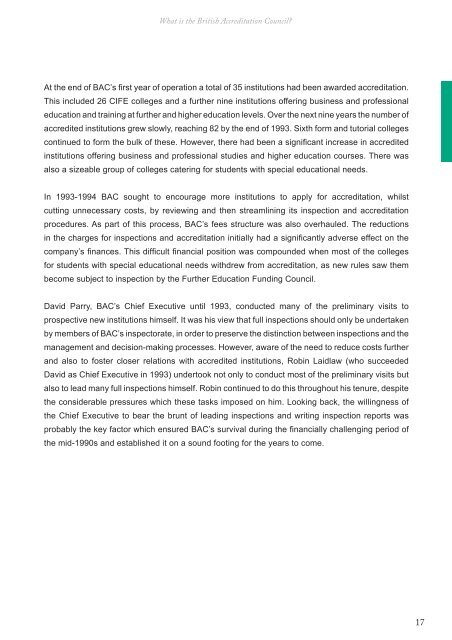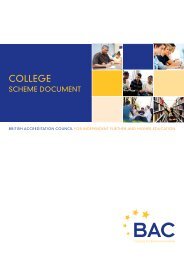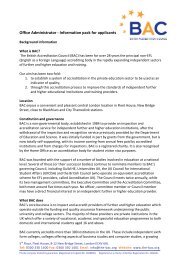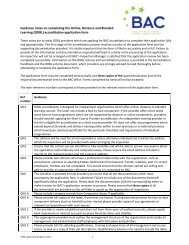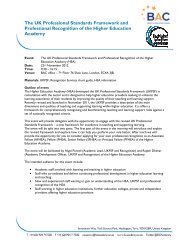A History of BAC's first 25 years
A History of BAC's first 25 years
A History of BAC's first 25 years
Create successful ePaper yourself
Turn your PDF publications into a flip-book with our unique Google optimized e-Paper software.
What is the British Accreditation Council<br />
At the end <strong>of</strong> BAC’s <strong>first</strong> year <strong>of</strong> operation a total <strong>of</strong> 35 institutions had been awarded accreditation.<br />
This included 26 CIFE colleges and a further nine institutions <strong>of</strong>fering business and pr<strong>of</strong>essional<br />
education and training at further and higher education levels. Over the next nine <strong>years</strong> the number <strong>of</strong><br />
accredited institutions grew slowly, reaching 82 by the end <strong>of</strong> 1993. Sixth form and tutorial colleges<br />
continued to form the bulk <strong>of</strong> these. However, there had been a significant increase in accredited<br />
institutions <strong>of</strong>fering business and pr<strong>of</strong>essional studies and higher education courses. There was<br />
also a sizeable group <strong>of</strong> colleges catering for students with special educational needs.<br />
In 1993-1994 BAC sought to encourage more institutions to apply for accreditation, whilst<br />
cutting unnecessary costs, by reviewing and then streamlining its inspection and accreditation<br />
procedures. As part <strong>of</strong> this process, BAC’s fees structure was also overhauled. The reductions<br />
in the charges for inspections and accreditation initially had a significantly adverse effect on the<br />
company’s finances. This difficult financial position was compounded when most <strong>of</strong> the colleges<br />
for students with special educational needs withdrew from accreditation, as new rules saw them<br />
become subject to inspection by the Further Education Funding Council.<br />
David Parry, BAC’s Chief Executive until 1993, conducted many <strong>of</strong> the preliminary visits to<br />
prospective new institutions himself. It was his view that full inspections should only be undertaken<br />
by members <strong>of</strong> BAC’s inspectorate, in order to preserve the distinction between inspections and the<br />
management and decision-making processes. However, aware <strong>of</strong> the need to reduce costs further<br />
and also to foster closer relations with accredited institutions, Robin Laidlaw (who succeeded<br />
David as Chief Executive in 1993) undertook not only to conduct most <strong>of</strong> the preliminary visits but<br />
also to lead many full inspections himself. Robin continued to do this throughout his tenure, despite<br />
the considerable pressures which these tasks imposed on him. Looking back, the willingness <strong>of</strong><br />
the Chief Executive to bear the brunt <strong>of</strong> leading inspections and writing inspection reports was<br />
probably the key factor which ensured BAC’s survival during the financially challenging period <strong>of</strong><br />
the mid-1990s and established it on a sound footing for the <strong>years</strong> to come.<br />
17


